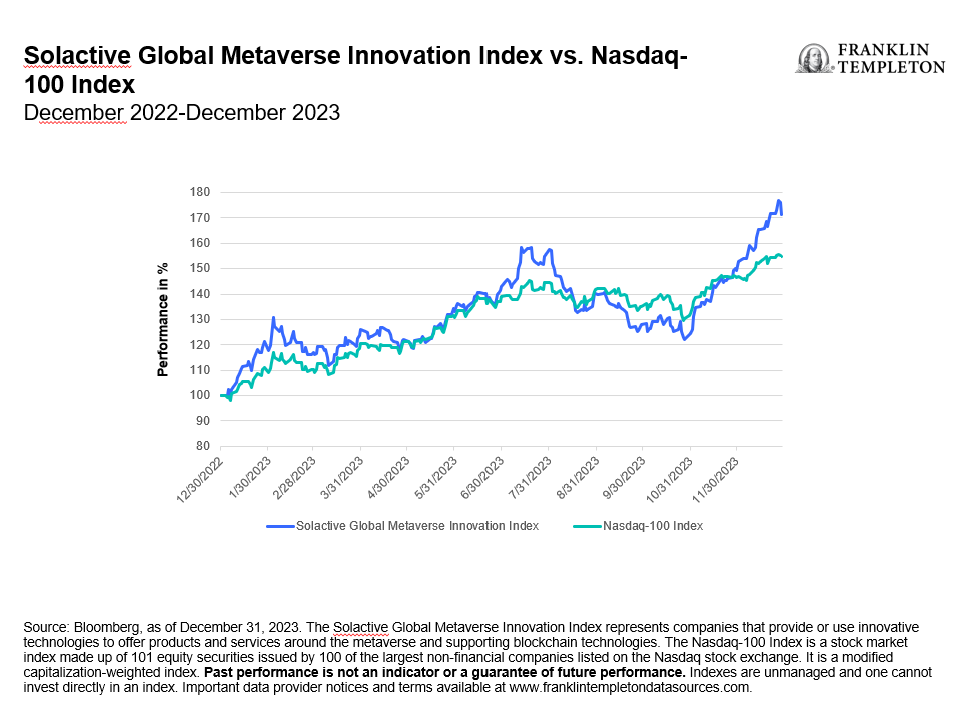Key takeaways:
- Last year, artificial intelligence (AI) and metaverse-related stocks outperformed the broad technology sector by double digits.
- The Application Software and Interactive Media sub-industries were the main drivers behind the 71% performance of the Solactive Global Metaverse Innovation Index in 2023.
- Applications span a vast spectrum of use cases, from entertainment and retail to government and military.
- AI has emerged as a key technology that is improving, and in some cases transforming, the metaverse user experience.
The metaverse provides a decentralized, blockchain-based virtual realm in which users can engage in immersive social, work, business and leisure experiences. In recent years, major corporations have embraced the metaverse to enhance efficiency in planning and manufacturing operations. For instance, leading German automaker BMW is leveraging NVIDIA’s Omniverse to simulate factory setups well before actual production commences. This proactive approach enables the company to detect and address issues as well as streamline processes and mitigate inefficiencies—ultimately saving real-world costs. Industrial metaverse usage may lack the glitz and entertainment of the consumer metaverse, which can feature leisure activities such as virtual beachside cafe get-togethers. But industrial use is projected to contribute significantly to the overall growth of the metaverse market, which could approach US$500 billion by the end of the decade.1
Both branches of the virtual world are increasingly tapping into another powerful technology—AI. AI not only enhances the quality of the user’s experience but is also transforming it. Consider a virtual cafe social for a moment; the more accurate your friends’ facial expressions and mannerisms are, the more authentic the interaction becomes. Additionally, perhaps you prefer a bustling atmosphere with other “people” frequenting the cafe. Here too, AI can help create a more life-like environment where you can interact with digital humans rather than stale, more traditional non-player characters (NPCs). Furthermore, if actual humans are indeed virtually present, you can engage with them in your preferred language due to AI advancements.
In South Korea, an early AI adopter, AI-generated K-pop bands are storming the charts and conquering the hearts of viewers. Beyond entertainment, Seoul has committed an initial US$180 million to building out its metaverse infrastructure. Technology research firm ABI Research expects that by 2030, some 700 cities globally are going to rely on the metaverse for eGovernment services, virtual tourism and the provision of remote working spaces.2
AI applications are arguably even more significant in the industrial metaverse, not the least in monetary terms. An example is Surgical Science, a provider of equipment and software for medical procedure simulations. Their simulations have shown substantial error reduction rates following training. Beyond medicine, AI-driven environments can accurately replicate real-world scenarios, making training more efficient, effective and essentially risk-free. For example, last year, the UK’s Royal Air Force partnered with an augmented reality (AR) technology firm to enhance their air combat training.3 The simulations not only cut costs and environmental impact but also significantly improve safety. With the help of AI, pilots wearing AR headsets can even train in close-range combat with full-color and high-resolution visuals, simulating scenarios practically impossible to replicate in traditional training setups.

Investors looking for high flying returns might also consider the metaverse. For the technology sector, last year was a comeback year, and metaverse and AI stocks did particularly well. With a 2023 performance of 71%, the Solactive Global Metaverse Innovation Index outpaced the Nasdaq-100 Index by some 17 percentage points.4 Overweightings in the application software and interactive media sub-industries, and substantial exposure to AI-related stocks nearing 40%, helped boost the Solactive Index’s performance. Despite the bold index composition, the metaverse index is only marginally pricier than the Nasdaq-100 on a cash flow basis (price-to-cash flow of 24.1 vs. 22.3), but a whopping 50% cheaper on a price-to-book basis.5
We believe that the metaverse’s position at the intersection of blockchain technology and AI continues to present compelling investment opportunities. As recent performance demonstrates, these sectors have remarkable growth potential. With its diverse applications across industries, an AI-powered metaverse promises to reshape how we interact, work and do business in the future. Investors can participate in these structural trends if they can stomach the innate volatility that comes with new technology investing.
WHAT ARE THE RISKS?
All investments involve risks, including possible loss of principal. Equity securities are subject to price fluctuation and possible loss of principal.
Investments in fast-growing industries like the technology sector (which historically has been volatile) could result in increased price fluctuation, especially over the short term, due to the rapid pace of product change and development and changes in government regulation of companies emphasizing scientific or technological advancement or regulatory approval for new drugs and medical instruments.
ETFs trade like stocks, fluctuate in market value and may trade above or below the ETF’s net asset value. Brokerage commissions and ETF expenses will reduce returns. ETF shares may be bought or sold throughout the day at their market price on the exchange on which they are listed. However, there can be no guarantee that an active trading market for ETF shares will be developed or maintained or that their listing will continue or remain unchanged. While the shares of ETFs are tradable on secondary markets, they may not readily trade in all market conditions and may trade at significant discounts in periods of market stress.
Commissions, management fees, brokerage fees and expenses may be associated with investments in ETFs. Please read the prospectus and ETF facts before investing. ETFs are not guaranteed, their values change frequently, and past performance may not be repeated.
Any companies and/or case studies referenced herein are used solely for illustrative purposes; any investment may or may not be currently held by any portfolio advised by Franklin Templeton. The information provided is not a recommendation or individual investment advice for any particular security, strategy, or investment product and is not an indication of the trading intent of any Franklin Templeton managed portfolio.
IMPORTANT LEGAL INFORMATION
This material is intended to be of general interest only and should not be construed as individual investment advice or a recommendation or solicitation to buy, sell or hold any security or to adopt any investment strategy. It does not constitute legal or tax advice. This material may not be reproduced, distributed or published without prior written permission from Franklin Templeton.
The views expressed are those of the investment manager and the comments, opinions and analyses are rendered as at publication date and may change without notice. The underlying assumptions and these views are subject to change based on market and other conditions and may differ from other portfolio managers or of the firm as a whole. The information provided in this material is not intended as a complete analysis of every material fact regarding any country, region or market. There is no assurance that any prediction, projection or forecast on the economy, stock market, bond market or the economic trends of the markets will be realized. The value of investments and the income from them can go down as well as up and you may not get back the full amount that you invested. Past performance is not necessarily indicative nor a guarantee of future performance. All investments involve risks, including possible loss of principal.
Any research and analysis contained in this material has been procured by Franklin Templeton for its own purposes and may be acted upon in that connection and, as such, is provided to you incidentally. Data from third party sources may have been used in the preparation of this material and Franklin Templeton (“FT”) has not independently verified, validated or audited such data. Although information has been obtained from sources that Franklin Templeton believes to be reliable, no guarantee can be given as to its accuracy and such information may be incomplete or condensed and may be subject to change at any time without notice. The mention of any individual securities should neither constitute nor be construed as a recommendation to purchase, hold or sell any securities, and the information provided regarding such individual securities (if any) is not a sufficient basis upon which to make an investment decision. FT accepts no liability whatsoever for any loss arising from use of this information and reliance upon the comments, opinions and analyses in the material is at the sole discretion of the user.
Products, services and information may not be available in all jurisdictions and are offered outside the U.S. by other FT affiliates and/or their distributors as local laws and regulation permits. Please consult your own financial professional or Franklin Templeton institutional contact for further information on availability of products and services in your jurisdiction.
CFA® and Chartered Financial Analyst® are trademarks owned by CFA Institute.
__________
1. Source: Statista Metaverse Worldwide Outlook, October 2023.
2. Source: ABI Research, October 2023.
3. Source: Red 6, June 20, 2023.
4. Source: Bloomberg, as of December 31, 2023. The Solactive Global Metaverse Innovation Index represents companies that provide or use innovative technologies to offer products and services around the metaverse and supporting blockchain technologies. The Nasdaq-100 Index is a stock market index made up of 101 equity securities issued by 100 of the largest non-financial companies listed on the Nasdaq stock exchange. It is a modified capitalization-weighted index. Past performance is not an indicator or a guarantee of future performance. Indexes are unmanaged and one cannot invest directly in an index. Important data provider notices and terms available at www.franklintempletondatasources.com.
5. Source: Bloomberg, as of February 2024.

